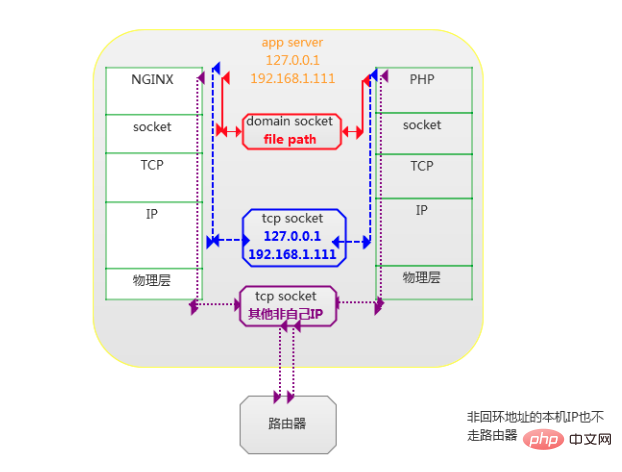 Backend Development
Backend Development
 PHP Tutorial
PHP Tutorial
 Let's talk about the communication mechanism between Nginx and php-fpm and see how to configure it?
Let's talk about the communication mechanism between Nginx and php-fpm and see how to configure it?
Let's talk about the communication mechanism between Nginx and php-fpm and see how to configure it?
This article will talk about the communication mechanism between Nginx and php-fpm, introduce the differences between the two communication methods, see how to configure the combination of Nginx and php-fpm, and analyze how to choose the communication method in the application. Hope it can help everyone!

PHP-FPM Introduction
CGI protocol and FastCGI protocol
Each dynamic language (PHP, Python etc.) code files need to pass the corresponding parser to be recognized by the server, and the CGI protocol is used to enable the interpreter and the server to communicate with each other. The parsing of PHP files on the server requires the use of a PHP interpreter, coupled with the corresponding CGI protocol, so that the server can parse PHP files.
Since the mechanism of CGI requires forking a CGI process for each request, and then killing the process after the request is completed, which is a waste of resources in practical applications, so an improved version of CGI, FastCGI, appeared. After processing, the process will not be killed, but multiple requests will continue to be processed, which greatly improves efficiency.
What is PHP-FPM
PHP-FPM is PHP-FastCGI Process Manager. It is the implementation of FastCGI and provides process management functions. The process includes two types: master process and worker process; there is only one master process, which is responsible for listening to the port and receiving requests from the server, while there are generally multiple worker processes (the specific number is configured according to actual needs), and each process will have one embedded in it. The PHP interpreter is where the code is actually executed.
Nginx and php-fpm communication mechanism
When we visit a website (such as www.test.com), the processing flow is like this:
www.test.com
|
|
Nginx
|
|
路由到 www.test.com/index.php
|
|
加载 nginx 的 fast-cgi 模块
|
|
fast-cgi 监听 127.0.0.1:9000 地址
|
|
www.test.com/index.php 请求到达 127.0.0.1:9000
|
|
等待处理...The combination of Nginx and php-fpm
On Linux, there are two ways of communication between nginx and php-fpm: tcp socket and unix socket.
The advantage of tcp socket is that it can cross servers. This method can only be used when nginx and php-fpm are not on the same machine.
Unix socket is also called IPC (inter-process communication) socket, which is used to implement inter-process communication on the same host. This method requires filling in the socket file location of php-fpm in the nginx configuration file. .
The data transmission process of the two methods is shown in the figure below: 
The difference between the two:
Due to Unix socket There is no need to go through the network protocol stack, package and unpack, calculate checksums, maintain sequence numbers and responses, etc. It just copies the application layer data from one process to another. Therefore, its efficiency is higher than that of tcp socket, which can reduce unnecessary tcp overhead. However, unix sockets are unstable when concurrency is high. When the number of connections explodes, a large number of long-term caches will be generated. Without the support of a connection-oriented protocol, large data packets may directly go wrong without returning an exception. Connection-oriented protocols such as tcp can better ensure the correctness and integrity of communication.
The combination of Nginx and php-fpm only requires settings in their respective configuration files:
1) Configuration in Nginx
Take tcp socket communication as an example
server {
listen 80; #监听 80 端口,接收http请求
server_name www.test.com; #就是网站地址
root /usr/local/etc/nginx/www/huxintong_admin; # 准备存放代码工程的路径
#路由到网站根目录 www.test.com 时候的处理
location / {
index index.php; #跳转到 www.test.com/index.php
autoindex on;
}
#当请求网站下 php 文件的时候,反向代理到 php-fpm
location ~ \.php$ {
include /usr/local/etc/nginx/fastcgi.conf; #加载 nginx 的 fastcgi 模块
fastcgi_intercept_errors on;
fastcgi_pass 127.0.0.1:9000; # tcp 方式,php-fpm 监听的 IP 地址和端口
# fasrcgi_pass /usr/run/php-fpm.sock # unix socket 连接方式
}
}2) Configuration of php-fpm
listen = 127.0.0.1:9000 # 或者下面这样 listen = /var/run/php-fpm.sock
Note that when using unix socket to connect, since the socket file is essentially a file, there are permission control issues, so you need to pay attention to the nginx process There is a problem with the permissions of php-fpm, otherwise it will prompt that there is no permission to access. (Set users in respective configuration files)
The communication between php-fpm and nginx can be completed through the above configuration.
Selection in application
If nginx and php-fpm are running on the same server, and the concurrency is not high (no more than 1000), choose unix socket to improve nginx Communication efficiency with php-fpm.
If you are facing high concurrent business, consider using a more reliable tcp socket to maintain efficiency through operation and maintenance methods such as load balancing and kernel optimization.
If the concurrency is high but you still want to use unix socket, you can improve the stability of unix socket through the following methods.
1) Place the sock file in the /dev/shm directory. Place the sock file in the memory in this directory, so that the memory can be read and written faster.
2) Increase the backlog
The backlog default bit is 128, 1024. This value is best converted into your own normal QPS, and the configuration is as follows.
nginx.conf file
server {
listen 80 default backlog = 1024;
}php-fpm.conf file
listen.backlog = 1024
3) Add sock file and php-fpm instance
in/ Create a new sock file in dev/shm, load balance requests to two sock files through the upstream module in nginx, and map the two sock files to two sets of php-fpm instances.
Recommended learning: "PHP Video Tutorial"
The above is the detailed content of Let's talk about the communication mechanism between Nginx and php-fpm and see how to configure it?. For more information, please follow other related articles on the PHP Chinese website!

Hot AI Tools

Undresser.AI Undress
AI-powered app for creating realistic nude photos

AI Clothes Remover
Online AI tool for removing clothes from photos.

Undress AI Tool
Undress images for free

Clothoff.io
AI clothes remover

Video Face Swap
Swap faces in any video effortlessly with our completely free AI face swap tool!

Hot Article

Hot Tools

Notepad++7.3.1
Easy-to-use and free code editor

SublimeText3 Chinese version
Chinese version, very easy to use

Zend Studio 13.0.1
Powerful PHP integrated development environment

Dreamweaver CS6
Visual web development tools

SublimeText3 Mac version
God-level code editing software (SublimeText3)

Hot Topics
 PHP's Purpose: Building Dynamic Websites
Apr 15, 2025 am 12:18 AM
PHP's Purpose: Building Dynamic Websites
Apr 15, 2025 am 12:18 AM
PHP is used to build dynamic websites, and its core functions include: 1. Generate dynamic content and generate web pages in real time by connecting with the database; 2. Process user interaction and form submissions, verify inputs and respond to operations; 3. Manage sessions and user authentication to provide a personalized experience; 4. Optimize performance and follow best practices to improve website efficiency and security.
 PHP and Python: Different Paradigms Explained
Apr 18, 2025 am 12:26 AM
PHP and Python: Different Paradigms Explained
Apr 18, 2025 am 12:26 AM
PHP is mainly procedural programming, but also supports object-oriented programming (OOP); Python supports a variety of paradigms, including OOP, functional and procedural programming. PHP is suitable for web development, and Python is suitable for a variety of applications such as data analysis and machine learning.
 PHP and Python: Code Examples and Comparison
Apr 15, 2025 am 12:07 AM
PHP and Python: Code Examples and Comparison
Apr 15, 2025 am 12:07 AM
PHP and Python have their own advantages and disadvantages, and the choice depends on project needs and personal preferences. 1.PHP is suitable for rapid development and maintenance of large-scale web applications. 2. Python dominates the field of data science and machine learning.
 Choosing Between PHP and Python: A Guide
Apr 18, 2025 am 12:24 AM
Choosing Between PHP and Python: A Guide
Apr 18, 2025 am 12:24 AM
PHP is suitable for web development and rapid prototyping, and Python is suitable for data science and machine learning. 1.PHP is used for dynamic web development, with simple syntax and suitable for rapid development. 2. Python has concise syntax, is suitable for multiple fields, and has a strong library ecosystem.
 Why Use PHP? Advantages and Benefits Explained
Apr 16, 2025 am 12:16 AM
Why Use PHP? Advantages and Benefits Explained
Apr 16, 2025 am 12:16 AM
The core benefits of PHP include ease of learning, strong web development support, rich libraries and frameworks, high performance and scalability, cross-platform compatibility, and cost-effectiveness. 1) Easy to learn and use, suitable for beginners; 2) Good integration with web servers and supports multiple databases; 3) Have powerful frameworks such as Laravel; 4) High performance can be achieved through optimization; 5) Support multiple operating systems; 6) Open source to reduce development costs.
 PHP: Handling Databases and Server-Side Logic
Apr 15, 2025 am 12:15 AM
PHP: Handling Databases and Server-Side Logic
Apr 15, 2025 am 12:15 AM
PHP uses MySQLi and PDO extensions to interact in database operations and server-side logic processing, and processes server-side logic through functions such as session management. 1) Use MySQLi or PDO to connect to the database and execute SQL queries. 2) Handle HTTP requests and user status through session management and other functions. 3) Use transactions to ensure the atomicity of database operations. 4) Prevent SQL injection, use exception handling and closing connections for debugging. 5) Optimize performance through indexing and cache, write highly readable code and perform error handling.
 How to check the name of the docker container
Apr 15, 2025 pm 12:21 PM
How to check the name of the docker container
Apr 15, 2025 pm 12:21 PM
You can query the Docker container name by following the steps: List all containers (docker ps). Filter the container list (using the grep command). Gets the container name (located in the "NAMES" column).
 How to configure nginx in Windows
Apr 14, 2025 pm 12:57 PM
How to configure nginx in Windows
Apr 14, 2025 pm 12:57 PM
How to configure Nginx in Windows? Install Nginx and create a virtual host configuration. Modify the main configuration file and include the virtual host configuration. Start or reload Nginx. Test the configuration and view the website. Selectively enable SSL and configure SSL certificates. Selectively set the firewall to allow port 80 and 443 traffic.





